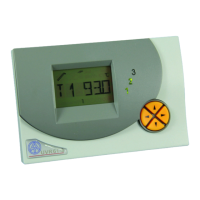58
Installation instructions
Installing the sensors
The sensors must be arranged and installed properly for the system to function correctly.
To this end, make sure that they are completely inserted in the immersion sleeves. The
threaded cable connections provided can be used to provide strain relief. The clip-on sensors
must be insulated to protect them from being influenced by the ambient temperature. Water
must be kept out of the immersion sleeves when used outdoors (
damage from freezing).
In general, the sensors may not be exposed to moisture (such as condensation water),
which might enter the cast resin and damage the sensor. If this happens, heating the sensor
to 90°C for an hour might help. When using immersion sleeves in NIRO cylinders
(inoxydable) or pools, pay attention to their
non-corrosion properties.
Collector sensor (red or gray cable with connection box): Insert either in the tube
directly soldered or riveted to the absorber and sticking out of the collector’s frame or in a t-
shaped connector on the outer collector’s supply line collector tube. Screw an immersion
sleeve with an MS (brass) threaded cable connection (= to protect from moisture) into this T-
shaped connector and insert the sensor. To protect from lightening, the connection box has
parallel overvoltage protection between the sensor and the extension cable.
Boiler sensor (boiler supply line): This sensor is either screwed into the boiler with an
immersion sleeve or attached to the boiler’s supply line at a slight distance.
cylinder sensor: The sensor that the solar power system needs should be used with an
immersion sleeve for fin coil heat exchangers just above the exchanger or, if integrated bare-
tube heat exchangers are used, on the lower third of the exchanger or the exchanger’s return
line so that the immersion sleeve is inside the exchanger’s tube. The sensor that monitors the
heating of the cylinder from the boiler is installed at the level of the desired amount of hot
water during the heating season. The plastic threaded cable connections provided can be
used to provide strain relief. They must not be installed below the register / exchanger.
Buffer sensor: The sensor that the solar power system needs is installed on the bottom of
the cylinder just below the solar heat exchanger using the immersion sleeve provided. The
plastic threaded cable connections provided can be used to provide strain relief. It is
recommended that the sensor be used between the middle and the upper third of the buffer
cylinder using the immersion sleeve as a reference sensor for the heater’s hydraulics or -
flush with the cylinder’s wall - under the insulation.
Pool sensor (swimming pool): Put a T-shaped connector on the suction line immediately
on the line leading from the pool and screw the sensor in with an immersion sleeve. In the
process, make sure that the material used is non-corroding. Another option is to put the
sensor on the same spot using hose clamps or adhesive tape and to provide thermal
insulation for ambient influences.
Clip-on sensor: Optimally secured using roll springs, pipe clamps or hose band clips to
the corresponding line. Make sure that suitable material is used (corrosion and temperature
resistance, etc.). Then, the sensor has to be well insulated so that the tube temperature can
be taken exactly and influences from the ambient temperature can be ruled out.

